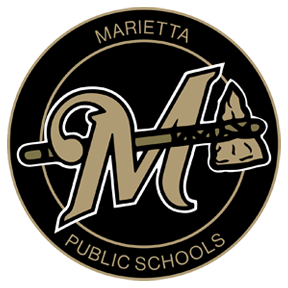After doing some research and talking to other local schools and finding them pleased with the service, Marietta’s Superintendent Brandi Naylor and the Board of Education members decided to partner with Keystone Food Service, an Oklahoma-based, family-owned company that focuses on providing freshly prepared breakfast and lunch options for the students it serves. The company serves over 50,000 students statewide, including those in Turner and Thackerville school systems.
“The ever-changing federal nutritional requirements and the state coding requirements were becoming a nightmare for us,” said Naylor. “Keystone takes care of those things, along with several others, and it was enough to convince us to give them a try.”
The services that Keystone provides for the school include planning menus that meet the strict USDA guidelines for fat and caloric intake; providing easy-to-follow recipes; providing an on-site company liaison to manage inventory; ordering foodstuffs and scheduling deliveries; providing paper goods and cleaning supplies; and handling the accounting necessary to meet the Oklahoma State Department of Education’s guidelines.
According to Cafeteria Supervisor Wendy Birks, two solid attributes that should work in favor of Keystone are saving time and money on paperwork and increasing the number of kids who eat in the cafeteria.
“We know that kids don’t learn if they’re hungry,” said Birks, “and we are hoping that our partnership with Keystone will help us to increase the number of students who are eating healthy meals in our cafeteria.”
The new system was implemented just a couple of weeks ago, so Birks’s staff members are still learning how to work with Keystone and how their methods can benefit the school.
Birks and her gang do like the addition of the salad bar with fresh fruits and veggies for middle and high school kids, and they also enjoy not having to count every calorie and fat gram, since the menu planners at Keystone take care of that for them.
“Our kids love the salad bar,” Birks remarked, “and we love getting to serve them more fresh fruits and vegetables.”
The cafeteria staff is also hoping to be able sometime soon to add a grab-and-go option for high school kids.
“Many of our high school kids drive themselves to school, and they won’t get up in time to come to the cafeteria to sit down and eat breakfast,” she said, “so we’d like to set up a cart near the high school so they could pick up something quick like fresh fruit, yogurt, or a breakfast bar, and then quickly go on to class.”
Birks also spoke of the possibility of a comparable grab-and-go option for lunch.
“There have been a few kinks,” said Birks, “but it’s getting better as we learn how everything works,”
Across campus in the superintendent’s office, there’s one member of the staff who really, really appreciates the Keystone partnership: Nati Sanchez, the Encumbrance/Accounts Payable Clerk. Part of Sanchez’s job used to be doing the dreaded coding, a part of the OSDE’s cost accounting system, better known as OCAS.
OCAS tracks every dollar that schools spend, whether it’s for books or buses, or in the cafeteria’s case, bread and milk. It’s how they make sure schools are accountable for spending your tax dollars in the best way.
“For our Child Nutrition fund, which pays for the cafeteria’s expenses, every invoice has to be coded by site – elementary, middle or high school – and by amount,” Sanchez said, “because the State Department of Education wants to be able to track every expenditure specifically.”
Every item has a function, object, program, subject, job classification, and operational unit, and all of those things are accounted for in a code. Every code is 27 digits long, officially longer than a nightmare. So every time that Sanchez codes a carton of milk or loaf of bread or pound of fruit, there’s a long, long numerical code that she uses to do it with. Coding for the cafeteria ate up several hours of Sanchez’s workweek, and she’s thrilled that Keystone has taken that responsibility away from her.
“Keystone now does the coding for our Child Nutrition fund,” said Sanchez, “which saves me hours of time, not to mention the headache of making sure that all of those 27-digit codes were done correctly. Because if those codes are wrong, it’s a problem for the school.”
Another way that Keystone will make the paperwork load lighter is one that won’t be evident right now, but will in the future.
“Current cafeteria employees are and will remain employees of Marietta Public Schools with the same salary schedule and benefits,” said Naylor. “As employees retire or leave, the new hires will transition to Keystone employees, further reducing the reporting and paperwork associated with child nutrition.”
So far the numbers look good. Last year, the cafeteria’s average number of student lunches was 664. And although there has been an increase in enrollment, it’s not enough to account for the 704 kids that the cafeteria staff fed on Monday, September 16. Based on that number, Birks has asked the Keystone representative to plan for 750 in future weeks. That increase equates to more full bellies, which should translate to more fuel for learning, and that’s what it’s all about for schools.
“We know that change is difficult, and we appreciate our cafeteria staff for working so hard to implement this new system,” said Naylor. “They are a great group and they are the ones that will make the new food service plan successful.”
